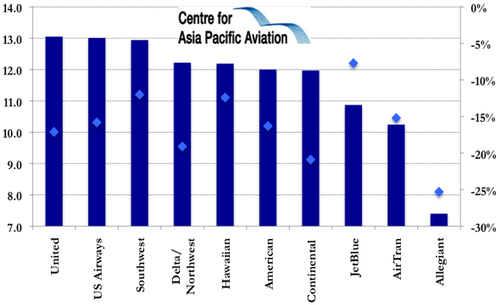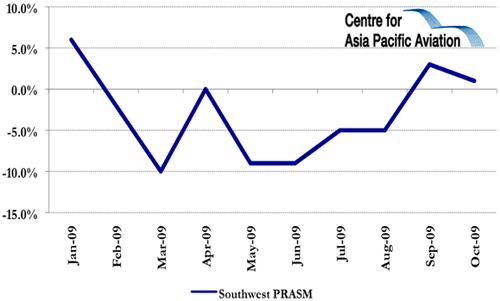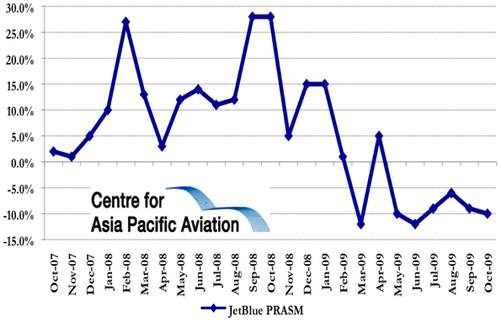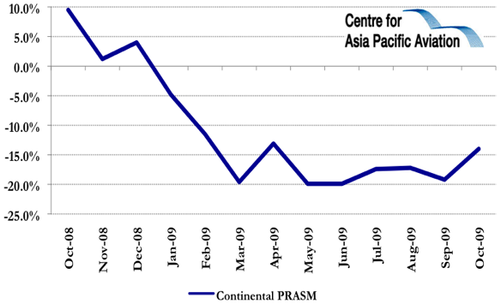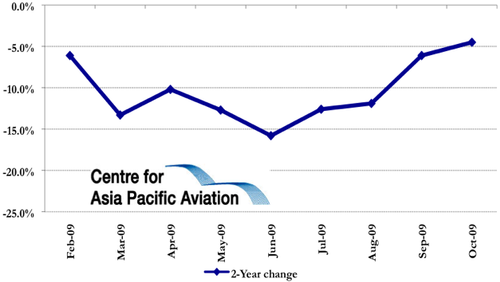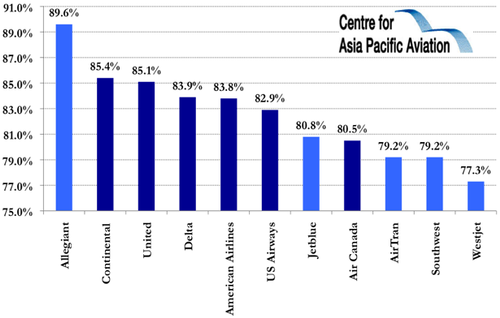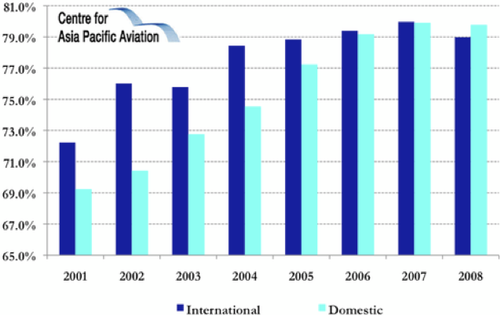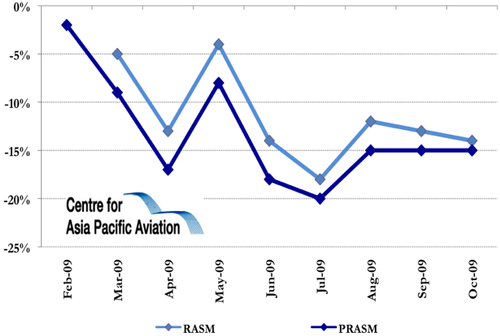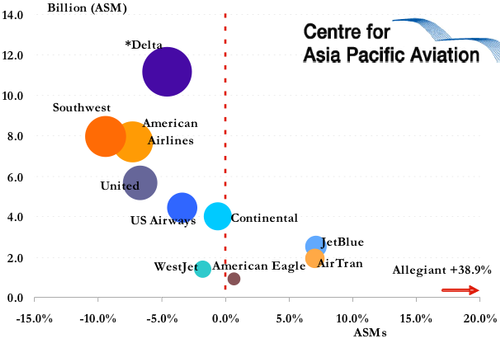AirTran, Allegiant sparkle; some signs of improvement but ATA downbeat: Americas Traffic Watch
JetBlue, US Airways and Continental Airlines reported continued yield weakness in Oct-2009, with the carriers continuing to feel the effects of the challenging operating environment. Southwest was the exception in the month, reporting PRASM growth of approximately 1%.
Southwest trumps JetBlue, US Airways and Continental in the yield growth stakes
Southwest traffic highlights: Oct-2009
|
|
PRASM |
RASM |
|---|---|---|
|
Southwest (Estimated) |
+1% |
n/a |
|
JetBlue (Estimated) |
-10% |
n/a |
|
US Airways (Estimated) |
-10% |
-9% |
|
Continental (Estimated) |
-14% to -15% |
-15% to -16% |
During 3Q2009, Southwest's passenger yields, while slipping 12.0% to USD 12.94 (as discounting activity reduced the average passenger fare by 8.4% to USD113.95) were higher than the other LCCs, and even some of the network carriers.
Select US carriers' yield (US cent miles) and yield growth (year-on-year change): 3Q2009
Load factor improvements across the board (with the exception of AirTran)
All but one of the eight US majors (with the exception of AirTran Airways) reported load factor improvements in Oct-2009, reflecting continued capacity reductions by the carriers and signs of a bottoming in demand.
US airlines domestic traffic^ highlights: Oct-2009
|
|
Traffic (RPMs) (bill) |
% Change |
Capacity (ASMs) (bill) |
% Change |
Load factor (%) |
% Change |
Traffic - pax (mill) |
% Change |
|---|---|---|---|---|---|---|---|---|
|
Delta/Northwest |
9.385 |
-4.4% |
11.191 |
-4.6% |
83.9% |
+0.2 ppts |
n/a |
n/a |
|
6.441 |
-3.2% |
7.688 |
-7.3% |
83.8% |
+3.6 ppts |
n/a |
n/a |
|
|
6.325 |
+1.9% |
7.987 |
-9.4% |
79.2% |
+8.8 ppts |
7.4 |
-0.7% |
|
|
4.821 |
-5.4% |
5.663 |
-6.7% |
85.1% |
+1.2 ppts |
n/a |
n/a |
|
|
3.696 |
-3.3% |
4.458 |
-3.4% |
82.9% |
+0.1 ppts |
3.9 |
-5.0% |
|
|
3.443 |
2.3% |
4.031 |
-0.6% |
85.4% |
+2.4 ppts |
n/a |
n/a |
|
|
2.017 |
+7.2% |
2.497 |
+7.1% |
80.8% |
+0.1 ppts |
1.7 |
+7.5% |
|
|
AirTran |
1.506 |
5.2% |
1.902 |
+7.0% |
79.2% |
-1.3 ppts |
2.0 |
+1.2% |
Only AirTran, JetBlue and Allegiant on the growth path
JetBlue and AirTran were the only two carriers among the majors growing capacity in the month, while among the smaller carriers, Allegiant stood out, with its continued expansionist strategy, which saw the carrier increase scheduled service capacity by almost 40%.
Southwest sees second consecutive month of PRASM improvements
Southwest stated it expects passenger revenue per ASM to have increased in the 1% range in Oct-2009 - for the second consecutive month of increases - thanks to large capacity cuts during the month.
Southwest PRASM year-on-year increase: Jan-2009 to Oct-2009
Southwest transported 7.4 million revenue passengers (-0.7% year-on-year), with load factors rising an impressive 8.8 ppts (to 79.2%) for four consecutive months of healthy load factor gains.
Southwest traffic highlights: Oct-2009
|
|
Oct-2009 |
% Change |
|---|---|---|
|
Traffic - revenue pax (mill) |
7.4 |
-0.7% |
|
Traffic RPMs (bill) |
6.3 |
+1.9% |
|
Capacity ASMs (bill) |
8.0 |
-9.4% |
|
Load factor (%) |
79.2% |
+8.8 ppts |
…and largest load factor gains
Southwest's load factor gains were larger than its US counterparts, with seven of the nation's eight largest carriers reporting improved load factor levels in Sep-2009. Southwest traditionally reports the lowest load factors among the major US airlines.
JetBlue yield weakness continues
JetBlue, meanwhile, experienced a 10% reduction in passenger revenue per available seat mile (PRASM) during Oct-2009 (off last year's very high base).
JetBlue passenger revenue (PRASM) growth (% change year-on-year): Oct-2007 to Oct-2009
Also in the month, the carrier reported a 7.5% increase in revenue passenger numbers to 1.7 million, while load factors gained slightly (+0.1 ppts to 80.8%).
JetBlue financial highlights: Oct-2009
|
|
Oct-2009 |
% Change |
|---|---|---|
|
Traffic - revenue pax (mill) |
1.7 |
+7.5% |
|
Traffic RPMs (bill) |
2.0 |
+7.2% |
|
Capacity ASMs (bill) |
2.5 |
+7.1% |
|
Load factor (%) |
80.8% |
+0.1 ppts |
Continental Airlines yield contractions continue in Oct-2009, but on the improve
Continental Airlines' yield contractions also continued in Oct-2009, for the tenth consecutive month of declines, the last nine of them double-digit, reflecting continued fare-cutting and weakness in premium travel.
For Oct-2009, the Houston-based carrier estimates that consolidated passenger revenue per available seat mile (RASM) was down by 14.0% to 15.0% (mainline RASM down by 15-16%). This represents the smallest monthly contraction for the carrier in six months, since Apr-2009's 13.1% decline (which was positively impacted by Easter falling in April this year, compared to March in 2008).
Continental Airlines' consolidated PRASM growth (% change year-on-year): Oct-2008 to Oct-2009
Looking at a two-year range, Continental's Oct-2009 RASM reduction was 4.5%, an improvement from contractions of 6.1% in Sep-2009, 11.9% in Aug-2009 and 12.6% in Jul-2009, and the smallest two-year range reduction reported in the past nine months.
Continental Airlines' consolidated PRASM growth (two year range): Feb-2009 to Oct-2009
For Sep-2009, Continental Airlines confirmed that consolidated passenger RASM decreased by 19.2%, at the higher end of the carrier's estimates of a 18.5%-19.5% reduction, while mainline passenger RASM decreased at a greater level that anticipated, at 21.1%, compared to estimates of a 20-21% reduction.
Domestic load factor of above 85% for Continental
In other traffic developments in the month, Continental Airlines' reported a consolidated (mainline plus regional) load factor of 82.5%, a 3.5 ppt load factor improvement, with a mainline load factor of 83.0%, also up 3.5 ppts. Domestic load factors gained 2.4 ppts to 85.4%, for the highest load factor level among the majors (Only Allegiant, with its unique model, operated with a higher occupancy).
US network carriers' occupancy levels higher than their LCC counterparts
This signals a key shift in the airline model in the US: America's full service airlines have pared back capacity so much that they are now consistently operating with higher load factors than their LCC competitors.
Comparatively, when LCCs first arrived on the scene, their keynote features were maximum utilisation of aircraft and of space, including a pricing model designed to deliver much fuller aircraft.
North American carriers' domestic passenger load factor in Oct-2009
Accordingly, the US domestic industry has seen a 10-11% load factor increase for 2008 over 2001 levels.
US carriers international and domestic passenger load factor: 2001 to 2008
US Airways also experiencing yield weakness, but seeing positive revenue trends ahead
In other passenger revenue news, US Airways President, Scott Kirby, stated that the carrier's Oct-2009 consolidated (mainline and Express) passenger revenue per available seat mile (PRASM) decreased approximately 10% year-on-year, while total revenue per ASM decreased approximately 9% on a year-over-year basis.
He added that the "revenue outlook continues to show material signs of improvement with continued strength in both close-in bookings and yields."
US Airways' RASM and PRASM growth (%): Jan-2009 to Oct-2009
Also in the month, US Airways reported a 3.3% domestic traffic (RPMs) reduction, as the carrier reduced domestic capacity (ASMs) by 3.4%, resulting in a 0.1 ppt load factor improvement to 82.9%.
AirTran reports record traffic and capacity levels for the month of October
AirTran, meanwhile, reported that traffic (RPMs) and capacity (ASMs) represented new all-time records for the LCC for the month of October. The carrier reported a 1.2% increase in passenger levels in the month, to 2.0 million, while load factor slipped 1.3 ppts to 79.2%.
AirTran traffic highlights: Oct-2009
|
|
Oct-2009 |
% Change |
|---|---|---|
|
Traffic -pax (mill) |
2.0 |
+1.2% |
|
Traffic RPMs (bill) |
1.5 |
+5.2% |
|
Capacity ASMs (bill) |
1.9 |
+7.0% |
|
Load factor (%) |
79.2% |
1.3 ppts |
Allegiant load factor slips for fifth consecutive month, but remains above 89%
Allegiant, which has been robust throughout the global economic slowdown, saw its passenger load factor slip for the fifth consecutive month in Oct-2009, although it reflects the carrier's massive 38.9% year-on-year increase in scheduled capacity (ASMs) (although this was lower than the 50-65% growth range experienced in the past three months).
Allegiant schedule service capacity (ASMs) growth: Feb-2007 to Oct-2009
This increase comes at a time when the majority of US carriers are reducing capacity, with only JetBlue, AirTran and American Eagle increasing capacity in the month (all of which were under 10%).
North American carriers' domestic passenger capacity growth (% change year-on-year): Oct-2009
Allegiant's scheduled service load factor declined 1.6 ppts in Oct-2009 to a still very solid 89.6%, with passenger numbers soaring 31.3% year-on-year to 319,980 (although this passenger figure is considerably lower than the major network and LCC carriers).
Allegiant monthly passenger traffic (millions) and load factor (%): 12 months to Oct-2008 vs 12 months to Oct-2009
Rapid expansion while others contract
Allegiant plans to continue to its growth trend in 4Q2009, with a capacity (ASM) increase of approximately 22% for a Full-Year capacity growth of approximately 22%. The growth is expected to continue into 2010, with a first quarter capacity growth of approximately 15%.
Allegiant Capacity and Departure Growth: 4Q2009, FY2009 and 1Q2010
|
|
4Q20209 Growth (year-on-year) |
FY2009 Growth (year-on-year) |
1Q2010 (year-on-year) |
|---|---|---|---|
|
ASM Growth - system |
Approximately 23% |
Approximately 22% |
Approximately 15% |
|
Departure Growth - system |
Approximately 15% |
Approximately 20% |
Approximately 7% |
|
ASM Growth - scheduled |
Approximately 23% |
Approximately 26% |
Approximately 15% |
|
Departure Growth - scheduled |
Approximately 16% |
Approximately 24% |
Approximately 7% |
|
Departures per day |
Approximately 2.4 |
n/a |
n/a |
|
Block hours per aircraft per day |
Approximately 5.6 |
n/a |
n/a |
Air travel demand remains weak as US airlines enter the seasonally weak Winter period
As ATA President and CEO, James C May, last month stated that the "demand for air travel remains weak, as evidenced by the untenable pricing environment".
He added, "while other sectors may be seeing signs that the economy is getting back on track, the airline industry has faced challenges in its effort to generate revenue".
According to ATA, passenger revenue, based on a sample group of carriers, fell 19% in Sep-2009, marking the 11th consecutive month in which passenger revenue has declined from the prior year, fuelled primarily by the tenth consecutive month of ticket price declines (the average price to fly one mile fell 18% in the month).
Separately, but illustrating the same point, the BTS stated that the average domestic airfares in 2Q2009 fell to their lowest level since 1998, dropping 13% year-on-year, for the largest year-to-year decline on record.
The year-on-year traffic and yield weaknesses are expected to continue this month, with ATA, on 09-Nov-2009, stating that it expects a 4% year-on-year reduction in passenger numbers on US airlines during the 2009 Thanksgiving holiday season (20-Nov-2009 through 01-Dec-2009), even despite the deep discounting activity.
According to Mr May, "it increasingly apparent that the economic head winds facing the airlines and their customers are anything but behind us". He added, "as typical with the Thanksgiving holiday travel period, flights are likely to be quite full, driven this year by the decrease in available seats and deep discounting, rather than by robust demand".
According to ATA, 2009 capacity reductions by US airlines have been the deepest since 1942. This careful capacity management, combined with opportunistic capital raising exercises, have however positioned the US airlines to survive the tough Winter that lies ahead. This capacity management has also meant that US airlines are operating at near record load factors, which is partially making up for reduced air fares.
However, according to ATA, while US airlines are now reporting improved load factors and are reducing costs (ATA stated its quarterly Airline Cost Index fell 29% to 183.9 in 2Q2009, for the second consecutive quarter of airline cost declines), there still exists an "unfavourable gap" between average break-even and actual load factors, currently at 1.8 ppts (from 6.3 ppts in the previous corresponding period).
